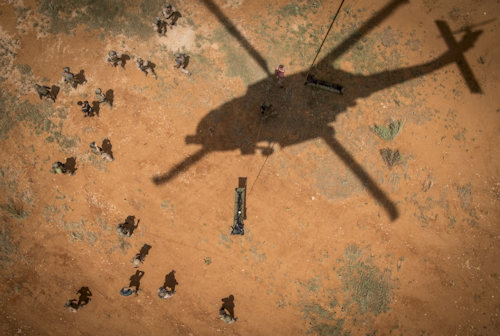This year marks the 15 years of the formation of Marine Corps Special Operations Command of the United States (MARSOC).
Created in 2006, the MARSOC is inserted into the USSOCOM (United States Special Operations Command) of Tampa, Florida, and is composed of the Marine Raider Regiment, from Marine Raider Support Group and from Marine Raider Training Center.
I Navy Raiders - which have their roots in the departments of Raiders of Marines operating in the Pacific during World War II - perform typical actions of special forces, such as direct actions, deep reconnaissance, counter-terrorism operations and mentoring (training of friendly military forces).
MARSOC was created to fill what the Pentagon saw as a gap to be filled in the context of special operations. From the very beginning, in fact, the military commitment of the United States in the global war on terrorism has identified special forces as the most suitable assets to effectively counter the jihadist militias.
Operational theaters, such as the Iraqi and Afghan ones, as well as other hotspots around the world, have proven right to those who have always asked to increase the number of departments capable of carrying out unconventional operations.
 However, controversies over the creation of the MARSOC for the Tampa Command persist and could jeopardize its existence in the future.
However, controversies over the creation of the MARSOC for the Tampa Command persist and could jeopardize its existence in the future.
After the disastrous operation Eagle Claw (v.articolo), in 1980, aimed at the liberation of American hostages in Iran, the Pentagon decided to create a joint command to coordinate the special departments of all the Armed Forces.
Established in 1987, the Special Operations Command (SOCOM), brought together special operations units such as the Special Groups of the Army, i SEAL Team of the Navy and the 160ᵗ ͪ Special Operations Aviation Regiment of the Air Force. The Marine Corps, considering the formula not very functional, refused the invitation.
In fact, the Marines already had some special operations units, namely i Marine Recon and Force-Recon, which focused on in-depth reconnaissance and direct action. They were considered special operations units by all but the Corps, which saw them as specialized infantry rather than commandos, a reflection of the mentality "Every Marine is special" prevalent in the Marine Corps since its creation.
So SOCOM and the Marine Corps went their separate ways until the terrorist attacks of September 11, 2001. Having seen the tactical and strategic value of special operations units in the early days of the World War on Terror, then Defense Secretary Donald Rumsfeld pushed to put more special forces under the control of the Tampa Command.
 Given that the international scenario has now completely changed, the Marine Corps reluctantly created the Detachment of the Special Operations Command (Det One) at the end of 2002 as a study unit to see if the Marines could fill special operations roles, according to the specifications required by SOCOM.
Given that the international scenario has now completely changed, the Marine Corps reluctantly created the Detachment of the Special Operations Command (Det One) at the end of 2002 as a study unit to see if the Marines could fill special operations roles, according to the specifications required by SOCOM.
However, since the reconnaissance Marines were already widely seen as a special operations unit, or its Marine equivalent, the Corps decision to establish Det One for further study, rather than incorporating the Marines immediately into SOCOM, it was seen by many as an attempt to stop the integration process until the Pentagon leadership moved or simply lost interest.
Undoubtedly, the first years were very fluctuating, as SOCOM did not pay due attention to newcomers and moreover the Naval Special Warfare Command he had expressed his intention to place the Marines under his control.
The truth is that neither SOCOM nor the Marine Corps wanted a special operations command of the marines, each of them for different reasons.
SOCOM believed that the Marine Corps had its chance to "operate" in 1987; the Marine Corps, on the other hand, believed they could perform their special operations as well or even better than SOCOM and did not want to lose highly trained Marines.

Anyway, Det One, led to the creation of the MARSOC in 2006.
The 1st and 2nd Force Reconnaissance Battalions were disbanded, with most of their operatives heading to the 1st and 2nd Battalions for Special Operations of the newly formed Marines, with a third battalion of Raider added later.
During the global war on terror, MARSOC made its contribution, but when the American commitment in many theaters fell away, the Navy Raiders they found themselves competing for missions and funds with units like the Special Groups of the Army oi Team of the SEALs.
As the MARSOC is the latest addition to Tampa Command, it tends to be relegated to less active areas of operations (ironically these regions can suddenly become quite challenging and Navy Raiders participated in some special operations of a certain level, such as the blitz against the jihadist organization al-Shabab, responsible for the attack on the Kenyan military base in Manda Bay in January 2020).
Despite an excellent track record, some Pentagon analysts have called for the deactivation of the MARSOC. However, at the moment, it would seem that these requests have fallen on deaf ears, even if the future for the Marines included in SOCOM certainly does not look bright.
Photo: US Marine Corps / US Navy












